Kansas City's Old Square Historical Marker
Introduction
Text-to-speech Audio
Prior to the bustling city following the construction of the stockyards and railroads, this site near the confluence of the Missouri and Kansas Rivers was a hub for commerce and trade. Located between the original French village of Chez les Canses and Francois Chouteau's Trading Post, this location was once the center of Gabriel Prudhomme's land, who was an early resident of the Kansas City area. Prudhomme owned and operated some of the first businesses in the Square, including a tavern and general store. Little remains of the original structures of Kansas City's original marketplace as they were subject to many floods over the years. City Market continues to offer an array of merchants, eclectic shops, and dining.
Images
English side of the marker, courtesy of William Fischer Jr
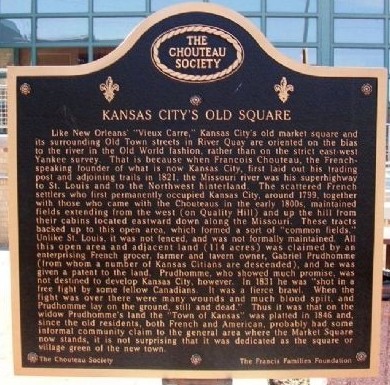
French side of the marker, courtesy of William Fischer Jr
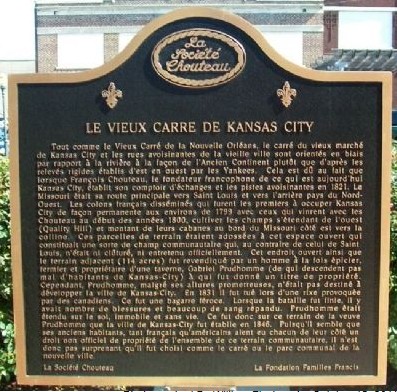
Market Square c.1886 near 4th Street and Main. Courtesy of Missouri Valley Special Collections, Kansas City Public Library, Kansas City, Missouri.
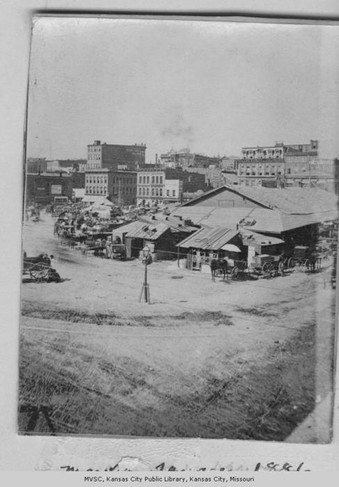
The City Market building c.1890. Courtesy of Missouri Valley Special Collections, Kansas City Public Library, Kansas City, Missouri.
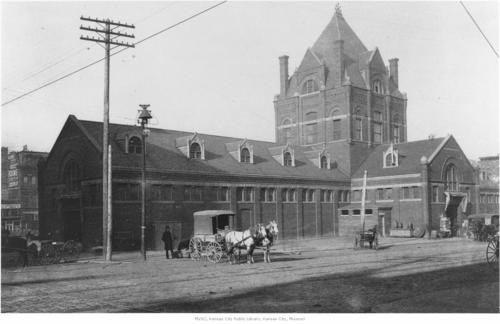
Francois Chouteau, one of the founders of the Chouteau Trading Post and Chez les Canses village
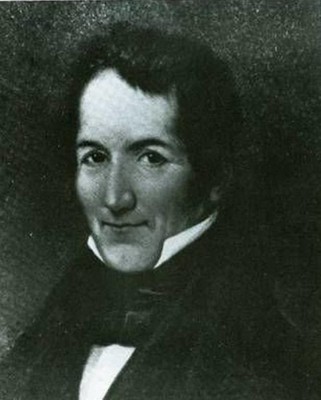
Drawing of the Chez les Canses village
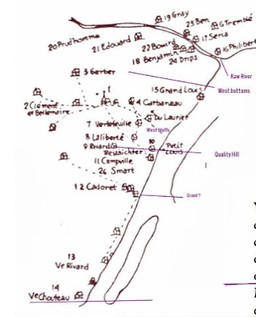
Backstory and Context
Text-to-speech Audio
Frenchmen mainly coming from Canada first began settling the area of modern day Kansas City in 1799 with the village of Chez les Canses. There were about two dozen families in this initial move, numbering a few hundred people. One of the initial families to move there was the Prudhomme family led by Gabriel Prudhomme who became somewhat of an unofficial leader of the group. At first this area was a true frontier and the settlers took time to tame the landscape for farming and building. Around 1820, more French speaking settlers began showing up in the area by coming up the Missouri River from St. Louis. This group was led by Francois Chouteau and his brothers who were seeking to expand their family business to the west.
The Chouteau’s were a very prominent fur trading family in St. Louis. Francois’s father Jean-Pierre and his brother Auguste Chouteau arrived at St. Louis in 1765 and quickly established themselves as the dominant name in the local fur trade. Francois Chouteau built several trade posts along the Kansas and Missouri Rivers, but the eventual long term one was built on the north bank of the Missouri a few miles east of Chez les Canses. Many inhabitants of the Chez les Canses village actively participated in the fur trade, and often spent months away from home on trapping and trading missions, leaving their wife and children to care for the family’s land.
Gabriel Prudhomme was one such man from the village who made a small fortune plying his craft in the fur trade. In 1831 he used this money to purchase 257 acres of land in between the village and the trading post. This land consisted of land south of the Missouri River and east of the Kansas River all the way down to modern day Independence. On this land, Prudhomme owned and operated several businesses including a tavern and general store. This area served as an early communal square for the inhabitants of Chez les Canses and the Chouteau Trading Post. Gabriel Prudhomme’s time in the town was short lived though as he was killed in a brawl shortly after his purchase of the land. Prudhomme’s land continued to be used communally and was later made the initial property boundaries of Kansas City when it was first platted as a town in 1846.
The text of this historical marker reads as follows:
Like New Orleans' "Vieux Carre," Kansas City's old market square and its surrounding Old Town streets in River Quay are oriented on the bias to the river in the Old World fashion, rather than on the strict east-west Yankee survey. That is because when Francois Chouteau, the French-speaking founder of what is now Kansas City, first laid out his trading post and adjoining trails in 1821, the Missouri river was his superhighway to St. Louis and to the Northwest hinterland. The scattered French settlers who first permanently occupied Kansas City, around 1799, together with those who came with the Chouteau's in the early 1800s, maintained fields extending from the west (on Quality Hill) and up the hill from their cabins located eastward down along the Missouri. These tracts backed up to this open area, which formed a sort of "common fields." Unlike St. Louis, it was not fenced, and was not formally maintained. All this open area and adjacent land (114 acres) was claimed by an enterprising French grocer, farmer and tavern owner, Gabriel Prudhomme (from whom a number of Kansas Citians are descended), and he was given a patent to the land. Prudhomme, who showed much promise, was not destined to develop Kansas City, however. In 1831 he was "shot in a free fight by some fellow Canadians. It was a fierce brawl. When the fight was over there were many wounds and much blood spilt, and Prudhomme lay on the ground, still and dead." Thus it was that on the widow Prudhomme's land the "Town of Kansas" was platted in 1846 and, since the old residents, both French and American, probably had some informal community claim to the general area where the Market Square now stands, it is not surprising that it was dedicated as the square or village green of the new town.
Sources
Kansas City's Old Square / Le Vieux Carre de Kansas City, Historical Marker Database. Accessed August 3rd, 2022. https://www.hmdb.org/m.asp?m=61220.
Gabriel Prudhomme, KC History. Accessed August 13th, 2022. https://kchistory.org/document/biography-gabriel-prudhomme-1791-1831-early-settler.
Hoig, Stan. The Chouteaus First Family of the Fur Trade. University of New Mexico Press, 2008.
The Prudhomme Farm, Flatland KC. Accessed August 13th, 2022. https://flatlandkc.org/people-places/founders-prudhomme-farm/.
https://www.hmdb.org/m.asp?m=61220
https://www.hmdb.org/m.asp?m=61220
https://kchistory.org/image/market-square
https://kchistory.org/image/city-market-building
https://alchetron.com/Fran%C3%A7ois-Chouteau#franois-chouteau-f9676610-fe6f-4bbc-a6f1-584363af831-resize-750.jpeg
https://newsantafetrailer.blogspot.com/2019/07/chez-les-canses-chouteaus-town-before.html
